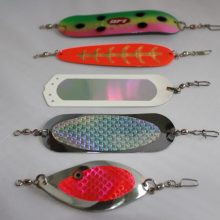This article may contain affiliate links. If you make a purchase after clicking on a link we may earn a small commission at no extra cost to you. As an Amazon Associate, I earn from qualifying purchases.
Flashers vs Dodgers – What’s the Difference?

If you have ever trolled for salmon or lake trout then you’ve probably used a down-rigger setup. Both flashers and dodgers are used extensively when trolling with a down-rigger.
They are used to attract salmon and trout to your lure or bait. However, they are not designed nor do they perform in the exact same way and knowing the difference between the two is crucial if you want to get the best performance from them.
Flashers vs Dodgers
The difference between flashers and dodgers is that the flasher is designed to spin as it is pulled through the water whilst the dodger will swing back and forth from side to side.
A flashers main purpose is to attract feeding trout or salmon from a distance by emitting a sharp flash as it spins and wobbles through the water.
A dodger is also used to attract fish but it has the added advantage of adding a sideways action to the lure on the end of your leader.
How to Use a Flasher for Trolling
A flasher is usually used when you want to troll at a speed of more than 2 mph. A flasher will usually have a mush longer length from the down-rigger release than a dodger. These lengths for a flasher can vary from 15 all the way up to 30 feet in length.
The bait or lure will generally be about 3 or 4 feet behind the flasher.
A Flasher is usable over a larger range of speeds than a dodger and it’s action is less susceptible to speed changes.
Usually in warmer temperatures you will be trolling deep and at a slightly higher speed than in the cooler months.
How to Use a Dodger for Trolling
A dodger is best trolled at less than 2 mph, so any time you are planning on trolling low and slow then the dodger is the best option.
A dodger will typically be used with a very short length from your release of roughly 27 inches.
Lake trout and Kokanee salmon are normally trolled at a slower speed. Dodgers will generally only work within a very small speed range. Once you go above a certain speed the dodger will start to spin or roll over on itself. When this happens you will loose it’s intended action and can quite often upset the nature of how the bait or lure is being presented.
Depending on the speed and time of year that you are trolling you can vary the distance between the dodger and the lure.
In colder months when fish are in shallower water and less aggressive you can use a smaller dodger and a slightly longer distance between the lure and the dodger. The longer distance will mean less of an action.
In warmer months when fish are more aggressive you can shorten the length so that the dodger imparts more of an action onto the lure. This added action can help to force more strikes from fish.
